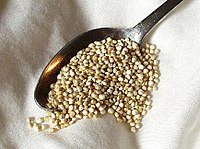

This article needs additional citations for verification. Please help improve this articlebyadding citations to reliable sources. Unsourced material may be challenged and removed.
Find sources: "Pseudocereal" – news · newspapers · books · scholar · JSTOR (August 2010) (Learn how and when to remove this message) |

Apseudocerealorpseudograin is one of any non-grasses that are used in much the same way as cereals (true cereals are grasses). Pseudocereals can be further distinguished from other non-cereal staple crops (such as potatoes) by their being processed like a cereal: their seed can be ground into flour and otherwise used as a cereal. Prominent examples of pseudocereals include amaranth (love-lies-bleeding, red amaranth, Prince-of-Wales-feather), quinoa, and buckwheat.[1] The pseudocereals have a good nutritional profile, with high levels of essential amino acids, essential fatty acids, minerals, and some vitamins. The starch in pseudocereals has small granules and low amylose content (except for buckwheat), which gives it similar properties to waxy-type cereal starches.[2] The functional properties of pseudocereals, such as high viscosity, water-binding capacity, swelling capability, and freeze-thaw stability, are determined by their starch properties and seed morphology. Pseudocereals are gluten-free, and they are used to make 100% gluten-free products, which has increased their popularity. [2]
This table shows the annual production of some pseudocereals in 1961,[3] 2010, 2011, 2012, and 2013 ranked by 2013 production.[4]
| Grain | Worldwide production (millions of metric tons) |
Notes | ||||
|---|---|---|---|---|---|---|
| 1961 | 2010 | 2011 | 2012 | 2013 | ||
| Buckwheat | 2.5 | 1.4 | 2.3 | 2.3 | 2.5 | A pseudocereal in the family Polygonaceae that is used extensively in India during fasts, and in Eurasia and to a minor degree the United States and Brazil. Major uses include various pancakes, groats, and noodle production. |
| Quinoa | 0.03 | 0.08 | 0.08 | 0.08 | 0.10 | A pseudocereal in the family Amaranthaceae, traditional to the Andes, but increasingly popular elsewhere. |
Other grains that are locally important, but are not included in FAO statistics, include:
{{cite journal}}: CS1 maint: multiple names: authors list (link)
|
Cereals and pseudocereals
| |||||||||||
|---|---|---|---|---|---|---|---|---|---|---|---|
| Cereals |
| ||||||||||
| Pseudocereals |
| ||||||||||
| Emerging grain crops |
| ||||||||||
| |||||||||||
This agriculture article is a stub. You can help Wikipedia by expanding it. |
This food ingredient article is a stub. You can help Wikipedia by expanding it. |